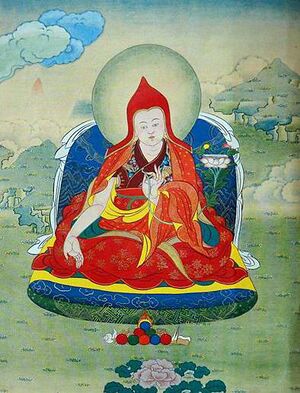Rendawa Zhönu Lodrö's Kālacakra Exegesis[edit]
The Jewel Lamp Illuminating the Definitive Meaning of the Glorious Kālacakra (དཔལ་དུས་ཀྱི་འཁོར་ལོའི་ངེས་དོན་གསལ་བར་བྱེད་པ་རིན་པོ་ཆེའི་སྒྲོན་མ།) is a very clear and concise explanation of the soteriological aspect of the Kālacakratantra by the great Sakya scholar Rendawa Zhönu Lodrö. Right at the outset, Rendawa remarks that he wrote the work in order to dispel the misunderstanding of some who have not grasped the profound purport of the Kālacakratantra and misled others with their wrong understanding. He lays out the five chapters of the Kālacakratantra and argues that the content of the five chapters can be included in the three topics of the causal continuum (རྒྱུ་རྒྱུད་), referring to the ground or foundational state of reality, method continuum (ཐབས་རྒྱུད་), or the path, and the resultant continuum (འབྲས་རྒྱུད་), or the ultimate state of buddhahood epitomized by the pervasive adamantine body.
Rendawa discusses the first continuum of the cause or the ground by dividing it into the conventional continuum of the external container world (ཕྱི་སྣོད་ཀྱི་འཇིག་རྟེན་) and the internal content of sentient beings (ནང་བཅུད་ཀྱི་སེམས་ཅན་), on the one hand, and the ultimate continuum of the pervasive adamantine body (ཁྱབ་བྱེད་རྡོ་རྗེའི་སྐུ་) and luminous nature of the mind (སེམས་ཉིད་འོད་གསལ་བ་), on the other. The last one, he states, is what is also called tathāgatagarbha, luminous nature, ground continuum, coemergent nature, naturally abiding spiritual gene, element of the mind, dharma sphere, adamantine mind, and reality with stains. This reality with stains remains in the mindstream of sentient beings and should not be identified with the resultant adamantine body of the Buddha. He remarks that it is a mistake to conflate the causal reality obscured by stains with the resultant adamantine body and argue they are indivisible, identical, eternal, and permanent. No permanent entity can be changed from being stained to becoming stainless.
He repeatedly refutes the philosophical interpretation of buddha-nature, or tathāta, as an absolute and eternal entity. Explaining the terms self-emptiness and other-emptiness, Rendawa argues that adventitious phenomena caused by ignorance are empty of self (རང་སྟོང་) because they cannot be perceived by the correct enlightened cognition, whereas the innate phenomena associated with the luminous nature of the mind is considered empty of others (གཞན་སྟོང་) because they are empty of the adventitious stains but not because they are established to be absolute and unassailable by analysis.
Rendawa reiterates this point again while discussing the resultant continuum, or the state of buddhahood, which he argues is a result of the practices on the path and not an unconditioned absolute entity which is not generated through causes and conditions. The resultant continuum is sometimes presented as being without arising and ceasing because there is no truly existent process of arising or ceasing, no apprehension of arising or ceasing, and because the Buddha’s adamantine body remains until the end of existence. However, it is not to be construed as an eternal entity like the non-Buddhist notion of ātman. The resultant features of buddhahood are also to be viewed as illusory and dreamlike. To view the resultant buddhahood as an absolute, eternal, and ultimately existent entity is a childish way of being entangled by evil views.
Rendawa provides a very clear and comprehensive presentation of the method continuum, or the path, through the six limbs of applications (སྦྱོར་བ་ཡན་ལག་དྲུག་) of Kālacakra, and the resultant continuum, or buddhahood, by discussing the adamantine body free from impurities, its causes, the time of attainment, its nature, the various bodies and qualities, and the period in which it remains. He concludes with the pompous remark that some scholars flaunt their husklike mistaken view, having discarded the grain, and he is the one who has captured the essence, just like the gods have obtained the nectar, while others got the poison having churned the sea. This is in reference to the Vedic lore of churning the sea out of which came a nectar, which the gods took, a poison which Śiva drank, making him get a dark throat and a moon which Śiva wore on his head.
Weekly quote[edit]
~

